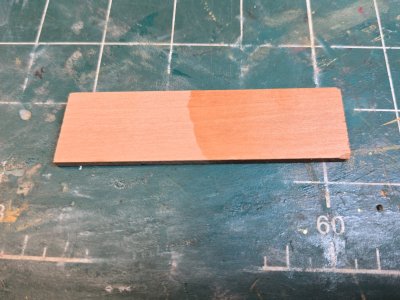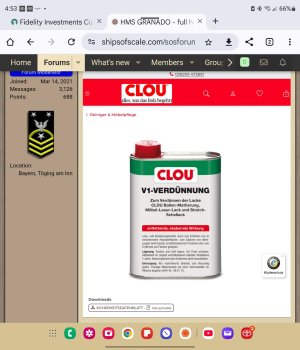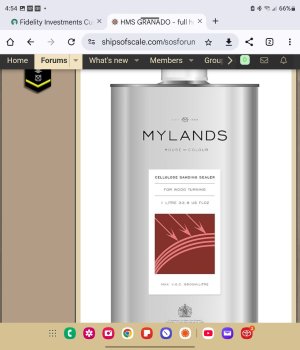-

Win a Free Custom Engraved Brass Coin!!!
As a way to introduce our brass coins to the community, we will raffle off a free coin during the month of August. Follow link ABOVE for instructions for entering.
You are using an out of date browser. It may not display this or other websites correctly.
You should upgrade or use an alternative browser.
You should upgrade or use an alternative browser.
I've got one in my Amazon cart.
Will experiment with it prior to my next build, as my BHR cross section is already finished with various shades of WATCO Danish Wood oil.
Hope it works the same as the European Clou!
Will experiment with it prior to my next build, as my BHR cross section is already finished with various shades of WATCO Danish Wood oil.
Hope it works the same as the European Clou!
- Joined
- Oct 15, 2017
- Messages
- 1,187
- Points
- 443

Hey Daniel,
Yes, I recommended it as I scoured North America for Clou. Mylands is cellulose-based, with a high solids count which was the key requirement I was looking for. That said, I do use it like Clou to protect the wood until I apply a final finish much later on in the project. That may be 2 years from now. One unknown, to me, is whether can it be stained or tinted AFTER it is applied. Sanding sealers, from everything I've read, is to create a uniform surface in preparation for staining. To prevent heavy grain soaking of stains resulting in blotchy ugly finishes. I have yet to test this, thoroughly. I plan to test wood after it's been treated (off-ship) with Mylands. See if I can then apply tinted oil or wax with bitumen. If this application fails, I'll attempt to tint the Mylands itself before the application of the wood.
I do really like Mylands, but beware, use it in a very, very, well-ventilated environment.
Looking at your image and the gloss, I'm assuming the photo is of the finish after it has been applied and dried with no additional treatment. I don't want to assume anything, so I don't know if what you show in your photo is the finish you are going for. If so, great.
I typically let it dry, then sand it with 340 grit, wipe it clean, and then hit it with 0000 steel wool. You may be very pleased with the satin-smooth, natural finish which is then protected.
Ok, Daniel, I will admit it, initially, I was going to admit I recommended Mylands, only if you were happy with it, but I decided to go out on a limb and throw caution to the wind.
Can't wait to see Mylands on your ship!!
Yes, I recommended it as I scoured North America for Clou. Mylands is cellulose-based, with a high solids count which was the key requirement I was looking for. That said, I do use it like Clou to protect the wood until I apply a final finish much later on in the project. That may be 2 years from now. One unknown, to me, is whether can it be stained or tinted AFTER it is applied. Sanding sealers, from everything I've read, is to create a uniform surface in preparation for staining. To prevent heavy grain soaking of stains resulting in blotchy ugly finishes. I have yet to test this, thoroughly. I plan to test wood after it's been treated (off-ship) with Mylands. See if I can then apply tinted oil or wax with bitumen. If this application fails, I'll attempt to tint the Mylands itself before the application of the wood.
I do really like Mylands, but beware, use it in a very, very, well-ventilated environment.
Looking at your image and the gloss, I'm assuming the photo is of the finish after it has been applied and dried with no additional treatment. I don't want to assume anything, so I don't know if what you show in your photo is the finish you are going for. If so, great.
I typically let it dry, then sand it with 340 grit, wipe it clean, and then hit it with 0000 steel wool. You may be very pleased with the satin-smooth, natural finish which is then protected.
Ok, Daniel, I will admit it, initially, I was going to admit I recommended Mylands, only if you were happy with it, but I decided to go out on a limb and throw caution to the wind.

Can't wait to see Mylands on your ship!!
While I haven't used Mylands sanding sealer, I have used Mylands friction polish. Primarily on pens that I have turned. I don't recommend it because it is fairly soft, deteriorates ans scratches easily. Maybe the sealer is better. Try it on scrap first to see what you think.Hey Daniel,
Yes, I recommended it as I scoured North America for Clou. Mylands is cellulose-based, with a high solids count which was the key requirement I was looking for. That said, I do use it like Clou to protect the wood until I apply a final finish much later on in the project. That may be 2 years from now. One unknown, to me, is whether can it be stained or tinted AFTER it is applied. Sanding sealers, from everything I've read, is to create a uniform surface in preparation for staining. To prevent heavy grain soaking of stains resulting in blotchy ugly finishes. I have yet to test this, thoroughly. I plan to test wood after it's been treated (off-ship) with Mylands. See if I can then apply tinted oil or wax with bitumen. If this application fails, I'll attempt to tint the Mylands itself before the application of the wood.
I do really like Mylands, but beware, use it in a very, very, well-ventilated environment.
Looking at your image and the gloss, I'm assuming the photo is of the finish after it has been applied and dried with no additional treatment. I don't want to assume anything, so I don't know if what you show in your photo is the finish you are going for. If so, great.
I typically let it dry, then sand it with 340 grit, wipe it clean, and then hit it with 0000 steel wool. You may be very pleased with the satin-smooth, natural finish which is then protected.
Ok, Daniel, I will admit it, initially, I was going to admit I recommended Mylands, only if you were happy with it, but I decided to go out on a limb and throw caution to the wind.
Can't wait to see Mylands on your ship!!





